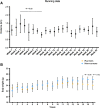A novel long term short interval physical activity regime improves body composition in mice
- PMID: 23422015
- PMCID: PMC3599771
- DOI: 10.1186/1756-0500-6-66
A novel long term short interval physical activity regime improves body composition in mice
Abstract
Background: Exercise training (ET) and physical activity (PA) offer obvious health benefits in regular participants. In pre-clinical animal models, treadmills and running wheels are the models of choice for intervention studies using ET and PA. However, the frequency and duration necessary for positive effects on health are not completely understood. We investigated the impact of short duration voluntary wheel running on body composition in FVB × C57BL/6 F1 hybrid mice over 22 weeks. Mice were randomized and given access to voluntary wheel running (N = 6) or locked wheels (N = 5) for 1 hour per night during the dark cycle, 5 days per week.
Finding: Average weekly running distance was generally cyclic in nature over the 22 weeks but did not change significantly from week to week, except for a difference between week 3 and week 9 (P = 0.05). Daily running distances ranged from 0.78 km to 1.45 km. Compared with non-runners, runners demonstrated significantly lower relative fat mass (9.98 ± 0.56% vs. 14.91 ± 1.47%, P = 0.0067) and significantly higher relative lean mass (79.18 ± 0.65% vs. 75.41 ± 1.28%, P = 0.019). No differences were observed with respect to glucose metabolism.
Conclusion: Voluntary wheel running for one hour a day five days a week over a five month period improved body composition in young adult mice. This repetitive short interval exercise regime should be a useful model to investigate the effects of structured moderate intensity physical activity on physiological performance and chronic disease conditions in mice.
Figures



References
-
- De Bono JP, Adlam D, Paterson DJ, Channon KM. Novel quantitative phenotypes of exercise training in mouse models. Am J Physiol Integr Comp Physiol. 2006;290:R926–R934. - PubMed
Publication types
MeSH terms
Grants and funding
LinkOut - more resources
Full Text Sources
Other Literature Sources

